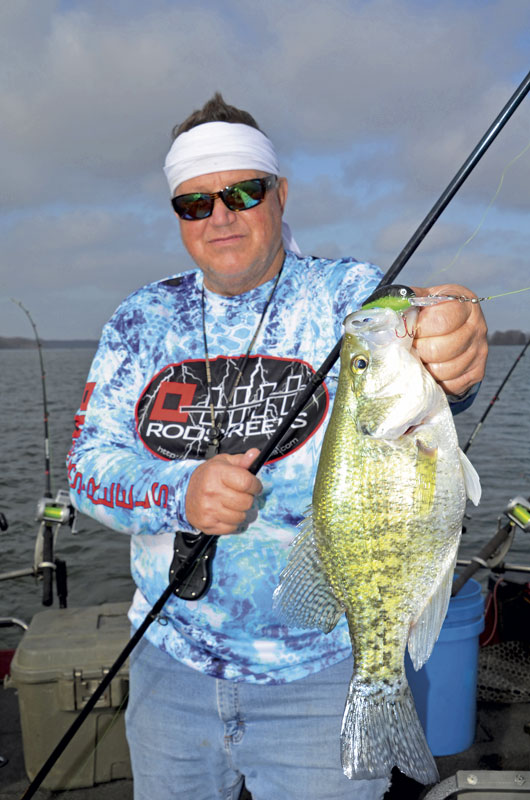
Variety of bass baits can also put slabs in the boat
Many anglers fish for crappie by dangling live minnows below floats tossed next to a fallen tree or other cover. Others fish small jigs or even jigs tipped with live minnows with a spider rig, an array of rods anchored in holders off the boat bow and pushed forward with trolling motor power.
Certainly, those proven methods still work and probably always will, but as many bass anglers grow older, they switch to crappie. When they switch, they sometimes take their old favorite tactics with them, with slight adaptations for crappie.
“I grew up crappie fishing and then got into bass fishing,” said John Harrison, a crappie guide from Jonesboro (318-278-3149, Facebook). “I fished bass tournaments for many years and then moved back to crappie fishing. There’s a lot of crossover between bass fishing and crappie fishing.”
Similar sized bass and crappie eat many of the same prey species, namely small fish. Bass anglers sometimes catch big crappie while crappie anglers commonly catch bass. Since they feed upon the same forage, bass and large crappie regularly hit similar lures. Anything that mimics a shad, minnow, shiner or other small fish might entice crappie or bass.
“Really large crappie hit large baits, just like bass,” said Jimmy Houston, a legendary professional bass angler and TV show host. “It takes a lot to fill them both up. Big crappie hit spinnerbaits, crankbaits or even large plastic worms. Big crappie often eat big shiners. With a bigger bait, anglers might not get as many bites, but they’ll usually catch bigger fish.”
Go big or not?
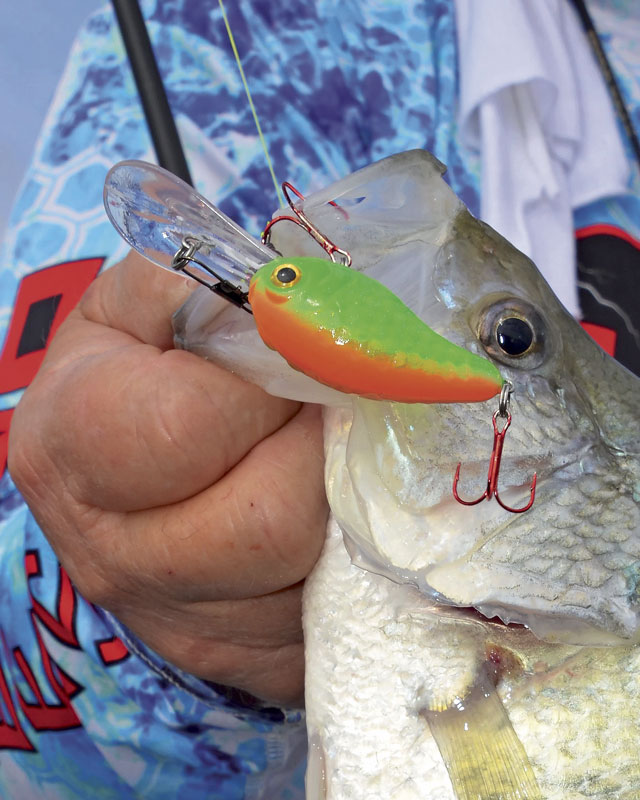
Although bass and crappie can hit the same lures, downsize for crappie. Also, work lures slower and less vigorously. While a bass likes an erratic bait, finicky crappie prefer subtle movement and typically won’t chase baits very far from their lair. Crappie also might stare at something a long time before pouncing on it.
“Most often, crappie want a smaller profile bait, but big crappie will eat big baits,” Harrison confirmed. “On Grenada Lake in Mississippi, I’ve seen big crappie with 4- to 6-inch shad in their throats and the tails hanging out. What they’re feeding on at that time dictates what I throw.”
Some crankbaits almost look like live baitfish. Many professional crappie anglers troll crankbaits and might rig several on different rods to fish various colors and depths simultaneously. At other times, they cast crankbaits.
“We pull a lot of Bandit 300 and Pico crankbaits,” said John Mayo with JH Guide Service, (662-983-5999) who fishes the northern Mississippi lakes. “We also use crankbaits custom painted by Delta’s Custom Crappie Cranks in Pearl, Miss. It’s one of the best-looking crankbaits on the market for crappie. We use one that dives to about 17 feet. Summer is the best time to pull crankbaits. We pull crankbaits from mid-May through the end of September. In the fall, crappie feed up for winter and eat bigger shad.”
Mayo and others rig several rods of varying lengths from eight to 20 feet. Mayo uses line-counter reels with 10-pound-test Gamma monofilament lines and puts four rods off each side of the boat. In the summer and early fall, he likes to keep the lures just above the thermocline, the invisible line where the warmer upper water layer and the colder lower layer meet. On hot days, crappie suspend just above the thermocline. Anglers can see it with good electronics.
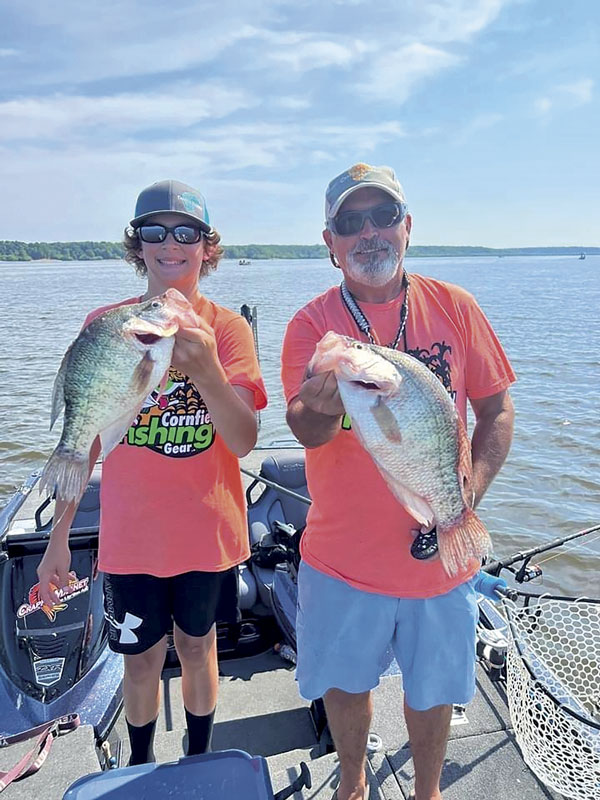
“Earlier in the morning, we start with the baits closer to the boat, about 75 to 80 feet,” Mayo said. “In September, it’s still hot in the South. When the sun starts getting up higher, we let baits go farther back behind the boat to about 170 to 180 feet. We pull crankbaits all summer in the deeper impoundments like Sardis Lake. On sunny days, I like bright colors. On dark days, I like dark colors.”
Crankin’ crappie
Sonar technology advanced giant leaps in recent years. Many high-tech units today display incredibly detailed information. Anglers throw lures at individual fish they see on their sonar. They can watch their lures on the screen and see how those fish react to that presentation in real time.
“Every bass fisherman who ever threw a crankbait has caught crappie on it,” Harrison said. “We catch big crappie on big crankbaits all year long. With forward-facing sonar, we throw crankbaits at individual crappie. What we throw depends upon what depth the crappie want to stay. In open water, crappie will hover at different depths.”
Whether casting or trolling, small lipless crankbaits also make excellent choices for tempting big crappie, especially ones holding in deeper water. Most baits sink at about one foot per second, which takes a long time to go deep. Although with a smaller profile, a heavy lipless crankbait full of rattling metal sinks quickly. Let it fall to just above suspended fish. Work the bait over the top of them, slower than when fishing for bass. Pause periodically to let the lure sink a few feet. As it falls, it looks like a dying shad.
“I have done well casting to crappie with small Rat-L-Traps,” Mayo said. “My favorite is a ½-ounce with a chrome and a blue back. Anything that imitates a threadfin shad might catch crappie. When fishing for crappie, the smaller the profile the better.”
Long and slender, jerkbaits also give off a smaller profile and resemble slim baitfish. The lure dives when the angler jerks the rod. Some jerkbaits float and others suspend or slowly sink. Use the sinking or suspending ones for crappie, especially when fishing deeper water.
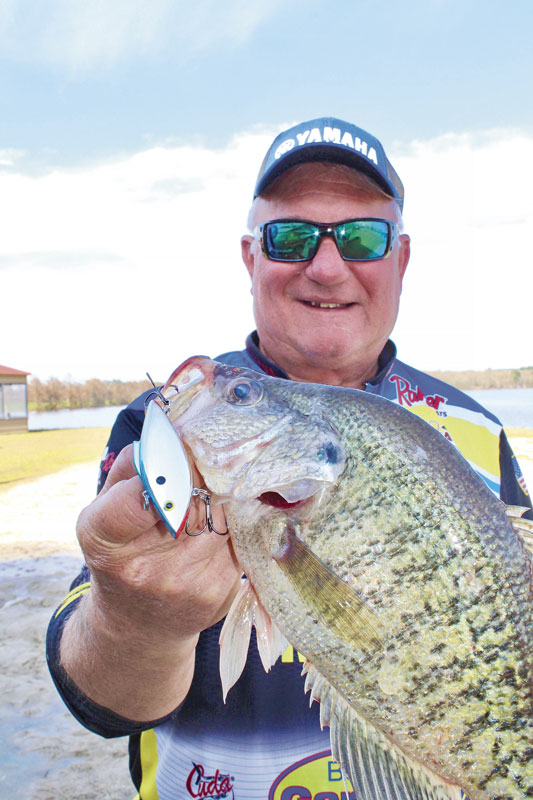
“I like to use a Rapala CountDown Jerkbait when using forward-facing sonar, especially in the summer and fall,” Mayo said. “We’ll find the fish with the sonar and cast toward individual crappie. I cast past the fish. The jerkbait sinks slowly. Let it sink until it’s two to three feet above the fish’s head. I make a slow retrieve and jerk it periodically. When the lure stops, it suspends for a second. That’s usually when fish strike.”
Probably no other lure more closely resembles minnows, shad and other baitfish than a swimbait. Crappie enthusiasts should use swimbaits in the 2.5- to 3.5-inch range.
“A swimbait is a good lure to use for casting at crappie we spot on the forward-facing sonar,” Harrison said. “Some companies make three- to 3.5-inch swimbaits specifically for crappie. Swimbaits on a tiny Alabama or umbrella rig are deadly on crappie. The rig simulates a school of baitfish. If crappie are chasing baitfish and an umbrella rig comes by with something that looks like what they want to eat, they’ll attack it. A small swim jig is another good crappie lure, a smaller version of the ones used for bass.”
Spinnerbaits, too
An old bass favorite, spinnerbaits also attract crappie. Bass anglers frequently catch large crappie on safety-pin style spinnerbaits. Small beetle spinners and in-line spinners tipped with feathers or fur also entice slabs. Spinnerbaits can usually slip through tight places where other lures would snag. Some companies now make safety-pin spinnerbaits in smaller sizes specifically to catch crappie. For crappie, use spinnerbaits in the 1/16- to 1/8-ounce range.
“I’ve caught a ton of crappie on H&H spinnerbaits,” Mayo said. “Sometimes, we’ll run a Crappie Magnet Pro Series Thin Spin with a 2.5-inch curly-tail soft-plastic bait behind it. That’s a deadly combination.”
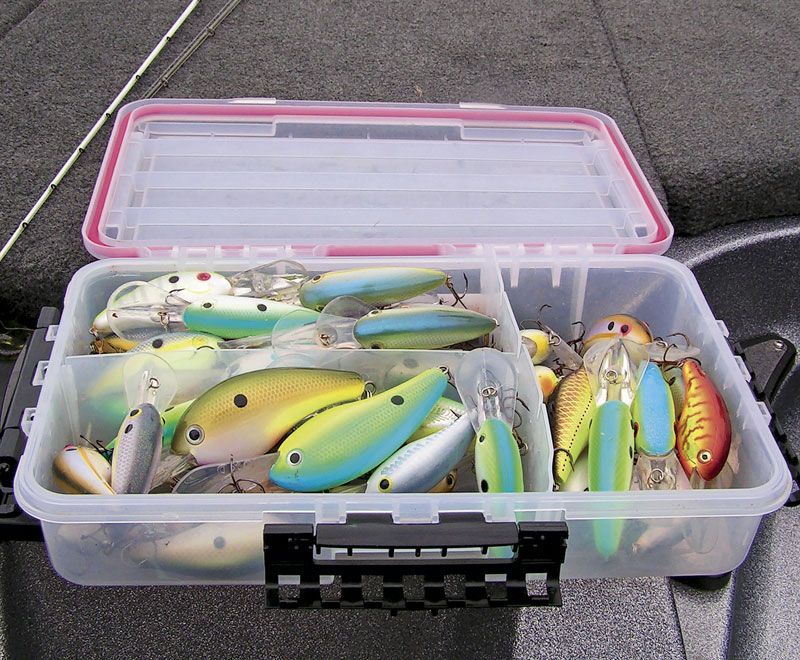
When crappie go really deep, try jigging a spoon, either fished vertically or when casting. Small, heavy and compact, a chrome jigging spoon sinks rapidly and flutters down like a dying shad. After the spoon hits bottom, lift it up a foot or two and hold it there for a while. Crappie don’t like as much motion as bass. If nothing hits, drop it to the bottom again or keep testing different depths.
Many other bass lures work on crappie. For fishing deep water, vertically fish a drop-shot rig. Above a weight, tie on a small plastic-bait. When the weight hits bottom, leave it there and just twitch the lure. Crappie occasionally even hit Texas-rigged plastic worms, jigs and sometimes topwaters.
“A small glide bait, a jointed lure that darts to the right and left, can be a great way to catch suspended crappie,” Harrison said. “Work it slowly. Crappie are going to stay where the baitfish are and they are going to eat what’s most readily available to them. Match the hatch. Throw something that mimics what crappie want to eat. A Ned rig would work for crappie.”
A finesse bait, a Ned rig consists of a light jighead with a plastic stick trailer. Anglers can work it like a wacky worm, just letting it fall and glide from side to side. Fish it on a slack line. Watch for the line for subtle movement. Also, crawl it along the bottom around stumps, brush piles and other cover.
Any of these proven bass techniques can put big crappie into the boat. Just don’t get in a hurry. Fish where crappie already want to feed and use something that looks like their preferred prey.


